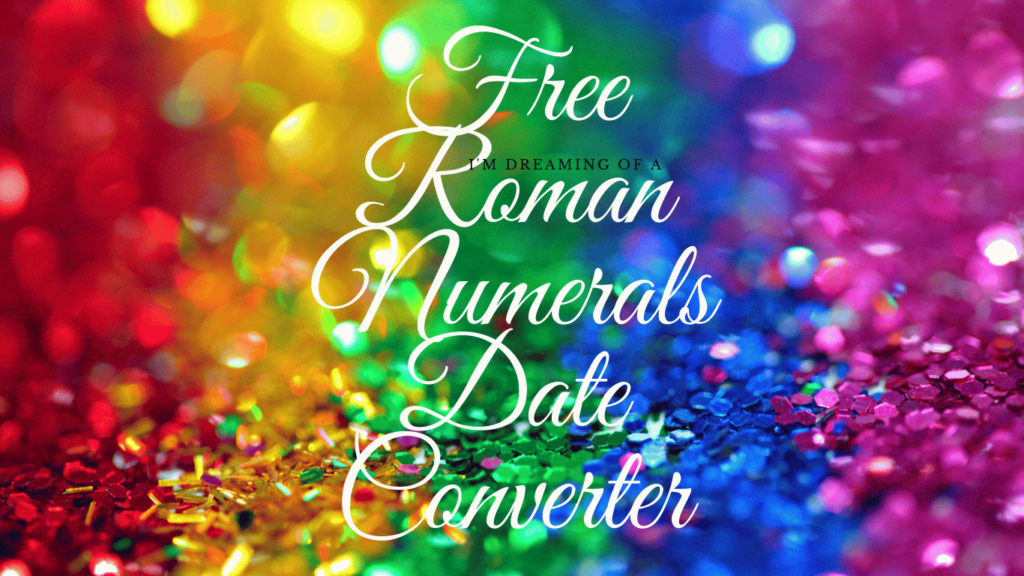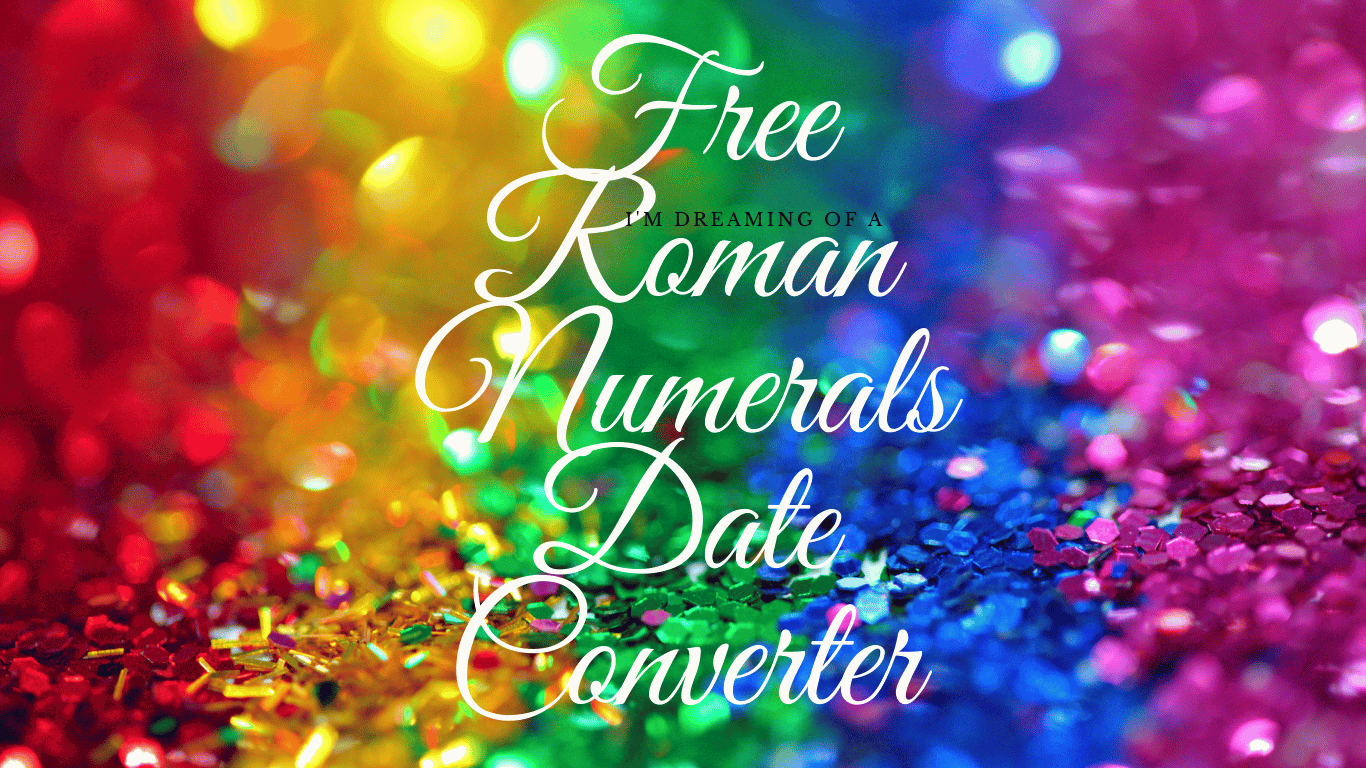Roman Numerals Date Converter
The Ultimate Guide to Free Roman Numerals Date Converters
In an age where digital convenience reigns supreme, there’s something elegantly timeless about Roman numerals. These ancient symbols continue to adorn clock faces, copyright notices, and commemorative inscriptions, lending a classic sophistication to modern contexts.

Among their many applications, representing dates in Roman numerals offers a distinctive alternative to standard numeric notation. Whether you’re designing a wedding invitation, commemorative plaque, or simply exploring historical context, understanding how to convert between conventional dates and Roman numerals can be both practical and fascinating.
The Historical Significance of Roman Numerals in Date Notation
Roman numerals originated, as their name suggests, in ancient Rome around the 7th century BCE. Unlike our current positional numeral system, Roman numerals are an additive system using combinations of letters to represent values. The standard symbols are I (1), V (5), X (10), L (50), C (100), D (500), and M (1000).
While ancient Romans didn’t record dates exactly as we might today, they did use their numeral system for calendrical purposes. The Roman calendar initially divided months into Kalends (first day), Nones (fifth or seventh day), and Ides (13th or 15th day), with other days referenced by counting backward from these fixed points. Years were often designated by the names of consuls in power, though later they would be counted from the founding of Rome (ab urbe condita or AUC).
As calendars evolved through the Julian and eventually Gregorian reforms, the representation of dates using Roman numerals persisted, particularly in formal and ceremonial contexts.
Understanding Modern vs. Ancient Roman Date Notation
Modern use of Roman numerals for dates differs significantly from ancient Roman practices. Today, we typically convert our familiar day/month/year format directly into Roman numerals. For example, January 1, 2025, would be written as I.I.MMXXV.
In contrast, the ancient Romans would have referenced this date very differently, potentially as “Kalendis Ianuariis” followed by the consular year or years since the founding of Rome. The direct conversion we use today is a modern convention that applies Roman numeral notation to our contemporary calendar understanding.
Free Online Roman Numeral Date Converter Tools
The digital age has simplified the conversion process through numerous online tools. These free converters instantly translate standard dates into their Roman numeral equivalents, eliminating the potential for conversion errors.
Top 5 Free Roman Numeral Date Converters
| Converter Name | Special Features | User Interface | Additional Functions | Mobile-Friendly |
|---|---|---|---|---|
| RomanDate.io | Custom formatting options | Clean, minimal | Historical date references | Yes |
| NumeralConverter | Bulk conversion capability | User-friendly | Educational explanations | Yes |
| DateToRoman | Personalized certificates | Interactive | Calendar visualization | Partial |
| RomanCalc | API access for developers | Technical | Mathematical operations | Yes |
| NumeriRomani | Multiple language support | Visual | Cultural context information | Yes |
These tools typically allow you to input a date through a calendar interface or text field and instantly receive the Roman numeral equivalent. Most offer customization options, such as different separator styles or abbreviated formats.
Manual Conversion: From Gregorian to Roman Numerals
Understanding the manual conversion process deepens your appreciation of the numeral system and ensures you can verify computer-generated results. Here’s the step-by-step process:
- Separate the date into day, month, and year components
- Convert each component individually to Roman numerals
- Combine using appropriate separators (typically periods or slashes)
Converting Years
Years often present the greatest challenge due to their size. Break down the year into thousands, hundreds, tens, and ones, then convert each place value:
- 2025 = 2000 + 0 + 20 + 5
- In Roman numerals: MM + (nothing for zero) + XX + V = MMXXV
Converting Months
Months are straightforward, requiring simple conversion of numbers 1-12:
- January (1) = I
- February (2) = II
- March (3) = III
- April (4) = IV
- May (5) = V
- June (6) = VI
- July (7) = VII
- August (8) = VIII
- September (9) = IX
- October (10) = X
- November (11) = XI
- December (12) = XII
Converting Days
Days follow the same principles, using numerals I through XXXI depending on the month.
Visual Conversion Reference
For quick reference, here’s a conversion chart for numbers 1-50 (the most commonly needed for date purposes):
| Arabic | Roman | Arabic | Roman | Arabic | Roman | Arabic | Roman | Arabic | Roman | ||||
|---|---|---|---|---|---|---|---|---|---|---|---|---|---|
| 1 | I | 11 | XI | 21 | XXI | 31 | XXXI | 41 | XLI | ||||
| 2 | II | 12 | XII | 22 | XXII | 32 | XXXII | 42 | XLII | ||||
| 3 | III | 13 | XIII | 23 | XXIII | 33 | XXXIII | 43 | XLIII | ||||
| 4 | IV | 14 | XIV | 24 | XXIV | 34 | XXXIV | 44 | XLIV | ||||
| 5 | V | 15 | XV | 25 | XXV | 35 | XXXV | 45 | XLV | ||||
| 6 | VI | 16 | XVI | 26 | XXVI | 36 | XXXVI | 46 | XLVI | ||||
| 7 | VII | 17 | XVII | 27 | XXVII | 37 | XXXVII | 47 | XLVII | ||||
| 8 | VIII | 18 | XVIII | 28 | XXVIII | 38 | XXXVIII | 48 | XLVIII | ||||
| 9 | IX | 19 | XIX | 29 | XXIX | 39 | XXXIX | 49 | XLIX | ||||
| 10 | X | 20 | XX | 30 | XXX | 40 | XL | 50 | L |
Common Conversion Mistakes to Avoid
When converting dates to Roman numerals, several errors frequently occur:
Incorrect Subtractive Notation
Remember that only certain combinations use subtractive notation (placing a smaller value before a larger one):
- IV (4), not IIII
- IX (9), not VIIII
- XL (40), not XXXX
- XC (90), not LXXXX
- CD (400), not CCCC
- CM (900), not DCCCC
All other combinations follow additive principles.
Misunderstanding Zero
Roman numerals have no symbol for zero. When converting years like 2005, you simply omit the hundreds place: MM (2000) + V (5) = MMV. There’s no placeholder for the absent hundreds and tens.
Format Inconsistency
While there’s no universal standard for date separators in Roman numeral notation, consistency within your chosen format is important. Common formats include:
- Day.Month.Year (IV.IX.MMXXV)
- Day/Month/Year (IV/IX/MMXXV)
- Day-Month-Year (IV-IX-MMXXV)
Practical Applications of Roman Numeral Dates
Roman numeral dates serve both practical and aesthetic purposes in contemporary contexts:
Formal Documentation
Roman numerals frequently appear on:
- Legal documents
- Diplomas and certificates
- Commemorative plaques
- Cornerstone inscriptions
- Wedding invitations and announcements
Design and Typography
The visual elegance of Roman numerals makes them popular in:
- Watch and clock face design
- Book chapter numbering
- Movie sequel titles
- Decorative date inscriptions
- Typographic layouts where their uniform height creates visual harmony
Cultural and Educational Value
Converting dates to Roman numerals offers:
- Educational opportunities to understand numerical systems
- Connection to historical traditions
- Cultural continuity with classical civilization
- Intellectual exercise in mathematical thinking
Significant Historical Dates in Roman Numerals
Converting pivotal historical moments to Roman numerals provides perspective on how these dates might appear in classical contexts:
- American Independence (July 4, 1776): IV.VII.MDCCLXXVI
- French Revolution (July 14, 1789): XIV.VII.MDCCLXXXIX
- End of World War II (September 2, 1945): II.IX.MCMXLV
- Moon Landing (July 20, 1969): XX.VII.MCMLXIX
- Berlin Wall Fall (November 9, 1989): IX.XI.MCMLXXXIX
- New Millennium (January 1, 2000): I.I.MM
- COVID-19 Pandemic Declaration (March 11, 2020): XI.III.MMXX
Converting Personal Dates
Personalizing Roman numeral dates often involves significant life events:
Birthday Conversion
Converting your birth date creates a distinctive personal symbol. For example, someone born on October 15, 1985, would represent this as XV.X.MCMLXXXV.
Anniversary Representation
Wedding anniversaries gain classical elegance when rendered in Roman numerals. A couple married on June 8, 2010, could commemorate their anniversary as VIII.VI.MMX.
Beyond Basic Conversion: Advanced Applications
For those seeking deeper engagement with Roman numeral date systems, several advanced applications exist:

Custom Date Formats
While month/day/year or day/month/year formats are common, you might also encounter:
- Year-only format for commemorative years (MMXXV)
- Month and year for publications (IX.MMXXIV)
- Julian date formats for astronomical purposes
Algorithmic Conversion
For programmers and developers, implementing Roman numeral conversion algorithms provides an interesting coding challenge, incorporating both mathematical logic and string manipulation.
The Future of Roman Numeral Dating in a Digital World
Despite our increasingly digital world, Roman numerals maintain relevance through their distinctive aesthetic and historical connections. As global society increasingly standardizes date formats for digital systems (typically using ISO 8601 format: YYYY-MM-DD), Roman numerals serve as a deliberate stylistic choice rather than a practical necessity.
This transformation from utilitarian system to cultural signifier demonstrates how ancient numerical systems evolve alongside human civilization. The continued use of Roman numerals for dates represents our ongoing dialogue with historical traditions, even as we embrace modern computational methods.
Answering Common Questions
How do I write my birth date in Roman numerals?
To convert your birth date, break it into day, month, and year components. Convert each number to its Roman numeral equivalent and combine with your preferred separator (typically periods). For example, May 27, 1992, becomes XXVII.V.MCMXCII.
What does MMXXIV mean as a date?
MMXXIV represents the year 2024. Breaking it down: MM (2000) + XX (20) + IV (4). Without day or month designations, this likely refers to the entire calendar year rather than a specific date.
Can all dates be written in Roman numerals?
Technically yes, though dates before 1 CE require special handling. The Roman numeral system can represent any positive integer, so any conventional calendar date can be converted. However, extremely large years (beyond several thousand) become unwieldy due to repeated M symbols.
Are there official rules for Roman numeral date formatting?
No universal standard exists for separators or ordering in Roman numeral dates. Common practice typically follows the same order as conventional dates in your region (MM/DD/YYYY in the US, DD/MM/YYYY in many other countries), with periods, slashes, or hyphens as separators.
Conclusion
Roman numeral date conversion represents more than a mere mathematical exercise—it creates a tangible connection between modern practices and ancient traditions. Whether used for aesthetic purposes, educational value, or cultural significance, Roman numeral dates continue to fascinate and find practical applications.

Free online converters have made this classical notation more accessible than ever, while understanding the underlying conversion principles enhances appreciation for different numerical systems. As we navigate an increasingly standardized digital world, these ancient symbols remind us of the rich diversity of human expression across time.
Whether you’re designing a wedding invitation with a distinctively classical touch or simply exploring numerical systems through history, Roman numeral dates offer both practical utility and timeless elegance. Their continued relevance demonstrates how even in our digital age, connections to historical traditions remain meaningful and enriching.

Leave a Reply